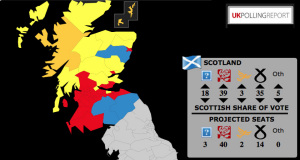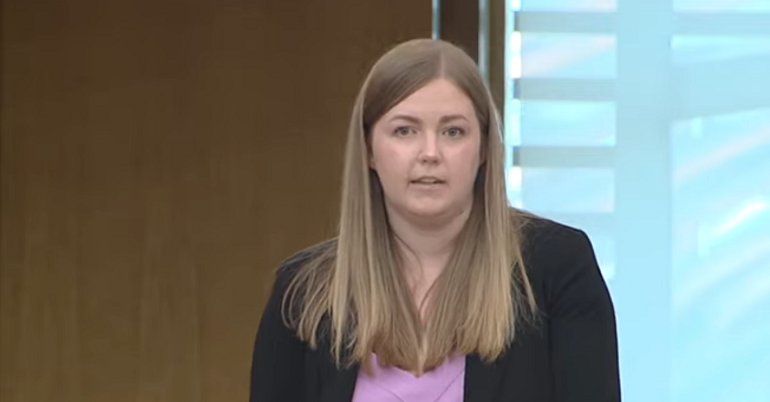Is a 2015 Scottish Labour wipe out on the cards?
The support for ‘Yes’ in some Labour heartlands, together with the recent success of the SNP, Scottish Greens and SSP in attracting new members has created some exited speculation about the 2015 UK Parliament seeing a collapse in Labour’s Scottish representation at Westminster. For example Kevin McKenna argued in today’s Observer that “Ed Miliband will require all of his 41 Scottish Labour MPs to be returned if he is to have any hope of winning an overall majority at Westminster next year. Yet how many of them would survive a backlash from among the 1.6 million who voted yes and who have effectively renounced the Labour faith?”
So how many would survive?
A Survation opinion poll taken after the referendum shows a major swing to the SNP – going from the 20% it got in the 2010 to 35%, which is a 75% increase it the vote. However the Labour vote is largely unchanged, only down a couple of percent on 2010. The real losers are the Lib Dems, who,it should be remembered were the second biggest party in the 2005 General Election in Scotland, and level pegging with SNP in the 2010 General Election, but who are apparently on only 3% now.
That is why if you plug the figures into the UK Polling Report website’s swingometer it shows that while this increase in SNP vote is predicted to lead to an increase in SNP seats (in this case from 6 to 14) it is likely to mainly come from the Lib Dems. Only Falkirk sees a Labour loss – even Dundee West would stay Labour on a uniform swing. That is because the scale of the existing Labour majorities is so huge that it would take an unprecedented swing to see Labour not win. Where Labour already get more than 50% of the votes, even if the SNP take every non-Labour vote they can’t win. Only when the Labour vote slips behind the SNP vote does the swingometer turn west central Scotland from red to yellow.
What is particularly interesting is the comparison between the tables for Westminster votes and Scottish Parliament votes. While only 35% of those surveyed said that they would vote SNP at Westminster, fully 49% of the same group said they would vote SNP for Holyrood. Some it appears that the split vote may be a very conscious choice. The survey also had an incredibly high number of undecided voters, so it is questionable how accurate a representation of reality it is. However it does show that even a remarkable SNP performance, which is what a 35% vote share would be, will not guarantee a decisive shift in representation (unless there is a dramatic shift in vote distribution across the country, but even the tiny Glasgow subsample still shows Labour leading for Holyrood 55% to 39%).
Rumours of Scottish Labour’s imminent Westminster demise therefore seem exaggerated..




A rather good prophecy, this article…
Andrew – visit http://ukpollingreport.co.uk/advanced-swingometer-map, enter your choice of figures into the Scotland section, press calculate at the bottom and you will get a clickable map broken down seat by seat.
Great article. Is there anywhere I could access a seat-by-seat breakdown of this?
Good article. Sobering against all the current hype.
What the “Labour wipe-out” theorists largely miss is both the inertia of labour votes in UK elections in industrial Scotland and how the campaign will be conducted.
The campaign will be characterised by Labour as one which is between the Tories and Labour for control of a UK Government. Only either of those parties can win. They will also characterise the fight as between Tory tax cuts for the rich and their (shameless lies) that they will defend ordinary people. The reality is that many, many people who voted YES in Glasgow will buy into this argument.
It’s a war of attrition that will take decades to win.
Hi Adam, of course you are right. We don’t know how the massive numbers of undecideds will break, what kinds of churn are being hidden by aggregated figures and crucially what geographical changes in swing may mean. This election is incredibly dynamic, with Scottish Labour today seek to co-opt the yes campaign through Gordon Brown’s petition. The SNP have inherited a campaign infrastructure from the referendum in a way that Labour probably haven’t. There is, as you say, a huge amount of chaos in the system. But my point was that there appears to be an an assumption on some people’s parts that Labour are facing an immanent and inevitable wipeout in Scotland in 2015. While this may indeed happen, no-one should underestimate the size of the task in overcoming the majorities Labour has built up in its core areas. There are massive numbers of people who have always voted Labour at Westminster to keep out the Tories, even if their votes have wandered for Europe and Holyrood. So, this election is going to be very interesting, but let’s temper predictions of imminent demise with an understand of Labour’s resilience.
I think there are a few things here:
1) the polls are kind of all over the place, but the YouGov aggregation a little before the referendum is shown here (at the end of the table):
http://www.electoralcalculus.co.uk/polls_scot.html
It puts Labour on 31% between 31 Aug and 24 Sept. That’s an 11% drop on their 2010 performance, and on a universal swing would give Labour 30 MPs and the SNP 23.
2) there are, as you note, a huge number of undecided voters – many more than you’d expect to see at this stage in an election. This introduces a load of chaos into the system…
3) I don’t think there will be a universal swing. My impression is that, in practice, there’s been a lot of churn – middle class former Lib Dems have gone to Labour, while working class Labour voters have switched to the SNP. Without more data crunching, I wouldn’t know what that means exactly for the result, but I think it’s worth thinking about.
4) It’s worth thinking for a moment about the dynamics of this election. If (as looks likely) UKIP have a run of by-elections into the general, and if the tussle over powers runs up into the elections (which it will) then there’s a serious possibility that a part of the narrative in the press is “other parties” and, also, is constitutions. Which can only play well for the SNP.
5) the circulation of the SNP email list will now be bigger than the readership of any Scottish broadsheet.
6) the SNP will have more than 1000 members per constituency…
Just worth considering…
Isn’t the issue about how soft the Labour majorities are? If Labour’s Westminster vote is different from their holyrood vote, then they get the former on the strength of their ability to be a better agent of popular will in Westminster than the alternatives. But if people have crossed a Rubicon with Scottish Labour, then big Westminster majorities aren’t as hard as they’d like. That’s the big question, whether the hold your nose and vote Labour emotion trumps the I can’t vote for these people again emotion. And on that we’ll find out in May.